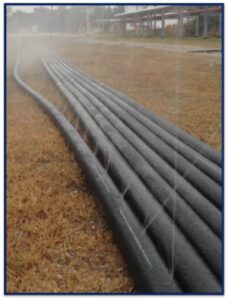Selecting the best way to implement a remediation technology is one of the most important factors that affect remediation performance. Horizontal remediation wells offer an alternative remedial implementation approach that can help overcome challenging site conditions. Read on to learn more about why horizontal wells are frequently chosen to implement in-situ remediation techniques at challenging sites and how your contaminated site may benefit from evaluating a horizontal remediation system.
What Are Horizontal Remediation Wells, and When Are They Used?
Horizontal remediation wells are used to provide precise delivery of a selected remediation technology to subsurface soil and groundwater contamination. Horizontal wells present an alternative to vertical wells and surface trenching. They can reach areas that may not be directly accessible due to surface obstructions and can be setbacks from sensitive areas. Remediation techniques that can be implemented with horizontal wells include air sparge, SVE, ISCO/ISCR injection, bioremediation, groundwater extraction, thermal, PRBs, and more. The most common questions that will help determine if horizontal remediation wells are a fit for a particular project are as follows: 1) is the contaminant plume partially inaccessible due to site constraints; 2) would disruptions to the site during remedial construction and O&M cause an issue; 3) is the time to achieve site closure an important factor; 4) does the size of the plume require 5 or more vertical wells; 5) have previous remediation efforts been unsuccessful in achieving site closure?
Horizontal remediation wells are installed parallel to the ground surface or at a shallow angle using horizontal directional drilling. They are drilled at a shallow angle, using specialized equipment to create a gently curved borehole to the desired depth. Once the target depth has been reached, the drill bit can be steered along a straight or curved path to target a specific feature, avoid obstructions, or follow the trajectory of a contaminant plume. Horizontal wells can bisect or follow the long axis of a contaminant plume or geologic feature to maximize contact with subsurface contamination. Wells can be installed in an entry-exit configuration with wellheads on either end of the bore or can be installed single-entry or “blind” where the bore is terminated at the target depth at the end of the well screen.
 What Are the Advantages of Using Horizontal Wells?
What Are the Advantages of Using Horizontal Wells?
Horizontal wells are the most comprehensive technological tool for overcoming various site limitations which could otherwise make remediation challenging. Common site conditions which limit the efficacy of vertical wells include lack of access to the area above the plume due to infrastructure or sensitive areas, industrial/commercial/residential uses of the property which cannot easily tolerate interruptions during remedial construction, and O&M, challenging geology, and future site redevelopment. Horizontal remediation wells can be used to implement any remediation strategies that could otherwise be used by a vertical well. Unlike conventional vertical remediation wells, horizontal remediation wells can access the contaminant plume from almost anywhere through the use of directional drilling techniques. Not only do horizontal remediation wells allow you to access the plume, but they are also far more effective at cleaning up contamination. A horizontal remediation well screen allows significantly more contact with the contaminant plume, allowing for more efficient treatment of wider areas of the subsurface and thorough coverage of the building footprint to prevent vapor intrusion. They can also be precisely targeted to focus on problematic hot spots. The resulting radius of influence that can be achieved by horizontal remediation wells allows for enhanced remediation performance and better management of the factors which cause of vapor intrusion.
Horizontal remediation wells are the most effective way to remediate a challenging site. They offer solutions to problems that traditional remediation techniques cannot resolve on their own. If you have a contaminated site that has vapor intrusion concerns, please click HERE to tell us about your project so that we can help you determine whether horizontal remediation wells may be an effective solution.